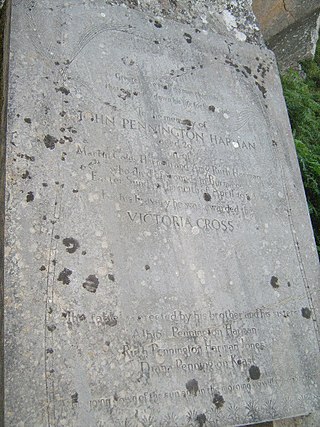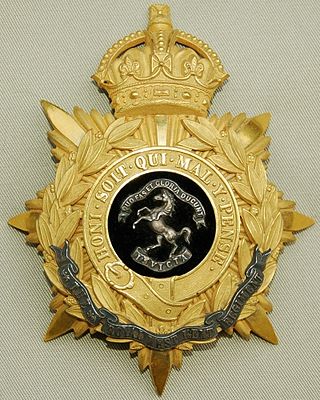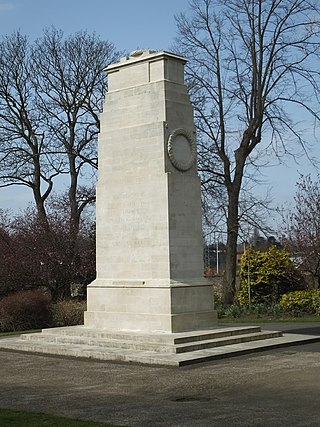Related Research Articles

Lance Corporal John Pennington Harman VC was a British Army soldier and an English recipient of the Victoria Cross (VC), the highest and most prestigious award for gallantry in the face of the enemy that can be awarded to British and Commonwealth forces.

John Coleman VC was an English recipient of the Victoria Cross, the highest and most prestigious award for gallantry in the face of the enemy that can be awarded to British and Commonwealth forces. He was a native of Norwich.

Charles Henry Lumley VC was a Scottish recipient of the Victoria Cross, the highest and most prestigious award for gallantry in the face of the enemy that can be awarded to British and Commonwealth forces.
Sergeant Thomas James Harris VC MM was a British Army soldier and an English recipient of the Victoria Cross (VC), the highest and most prestigious award for gallantry in the face of the enemy that can be awarded to British and Commonwealth forces.

The Queen's Own Royal West Kent Regiment was a line infantry regiment of the British Army based in the county of Kent in existence from 1881 to 1961. The regiment was created on 1 July 1881 as part of the Childers Reforms, originally as the Queen's Own , by the amalgamation of the 50th Regiment of Foot and the 97th Regiment of Foot. In January 1921, the regiment was renamed the Royal West Kent Regiment and, in April of the same year, was again renamed, this time as the Queen's Own Royal West Kent Regiment.

The 50th Regiment of Foot was an infantry regiment of the British Army, raised in 1755. Under the Childers Reforms it amalgamated with the 97th Regiment of Foot to form the Queen's Own Royal West Kent Regiment in 1881.

Maidstone Museum is a local authority-run museum located in Maidstone, Kent, England, featuring internationally important collections including fine art, natural history, and human history. The museum is one of three operated by Maidstone Borough Council. The building is Grade II* listed.
The 97th Regiment of Foot was an infantry regiment of the British Army, formed in 1824 and amalgamated into the Queen's Own in 1881.

The River Len is a river in Kent, England. It rises at a spring in Bluebell Woods to the southeast of the village centre of Lenham 0.6 miles (0.97 km) from the source of the River Great Stour; both rise on the Greensand Ridge. Its length is c10 miles (16 km). It enters the River Medway at Maidstone.
The West Kent Militia, later the 3rd Battalion, Queen's Own was an auxiliary regiment raised in Kent in South East England. From its formal creation in 1758 the regiment served in home and colonial defence in all of Britain's major wars until 1918, and supplied thousands of reinforcements to the Royal West Kents during World War I.
In countries whose armies are organised on a regimental basis, such as the army of the United Kingdom, a regimental museum is a military museum dedicated to the history of a specific army regiment.

The Queen's Own West Kent Yeomanry was a British Army regiment formed in 1794. It served in the Second Boer War and the First World War. It amalgamated with the Royal East Kent Yeomanry to form the Kent Yeomanry in 1920.

The regimental depot of a regiment is its home base for recruiting and training. It is also where soldiers and officers awaiting discharge or postings are based and where injured soldiers return to full fitness after discharge from hospital before returning to full duty. Normally, a variety of regimental stores will also be kept at the depot. The regimental depot is not the same as the regimental headquarters, though in practice the two will often be co-located in the same place.

Invicta Park Barracks is a military installation in Maidstone, Kent.

The Kent Yeomanry was an artillery regiment of the Territorial Army (TA) formed in 1920 by the amalgamation of the Royal East Kent Yeomanry and West Kent Yeomanry. For the Second World War it was expanded to form two field artillery regiments – 97 Field Regiment, Royal Artillery and 143 Field Regiment, Royal Artillery – which saw active service in North Africa, Italy and North-West Europe, both with the BEF in 1940 and on the Second Front in 1944–45. Post war it was reconstituted as 297 Light Anti-Aircraft Regiment, Royal Artillery before being amalgamated in 1961 with the 3rd/4th County of London Yeomanry (Sharpshooters) to form the Kent and Sharpshooters Yeomanry.

The Queen's Own Royal West Kent Regiment Cenotaph is a First World War memorial dedicated to members of the Queen's Own Royal West Kent Regiment and located in Maidstone in Kent, south-eastern England. Unveiled in 1921, the memorial was designed by Sir Edwin Lutyens following his design for the Cenotaph on Whitehall in London and is today a grade II* listed building.
The Royal Berkshire Regiment War Memorial or Royal Berkshire Regiment Cenotaph is a First World War memorial dedicated to members of the Royal Berkshire Regiment and located in Brock Barracks in Reading, Berkshire, in south-east England. Unveiled in 1921, the memorial was designed by Sir Edwin Lutyens, based on his design for the Cenotaph on Whitehall in London, and is today a grade II* listed building.

The Memorial to the Home of Aviation is a stone memorial sculpture at Eastchurch, on the Isle of Sheppey in the English county of Kent. The Grade II* listed memorial, unveiled in 1955, commemorates the early aviation flights from Leysdown and Eastchurch by members of the club that became the Royal Aero Club of Great Britain in 1910, and the air base established by the Royal Navy near Eastchurch in 1911.
The Kent Militia was an auxiliary military force in Kent in the South East England. From their formal organisation as Trained Bands in 1558 until their final service as the Special Reserve, the Militia regiments of the county served in home defence in all of Britain's major wars. They also saw active service during the Second Boer War, and trained thousands of reinforcements during World War I. After a shadowy postwar existence they were formally disbanded in 1953.
References
- ↑ "Queen's Own Royal West Kent Regiment Museum". Maidstine Museum. Retrieved 5 June 2018.